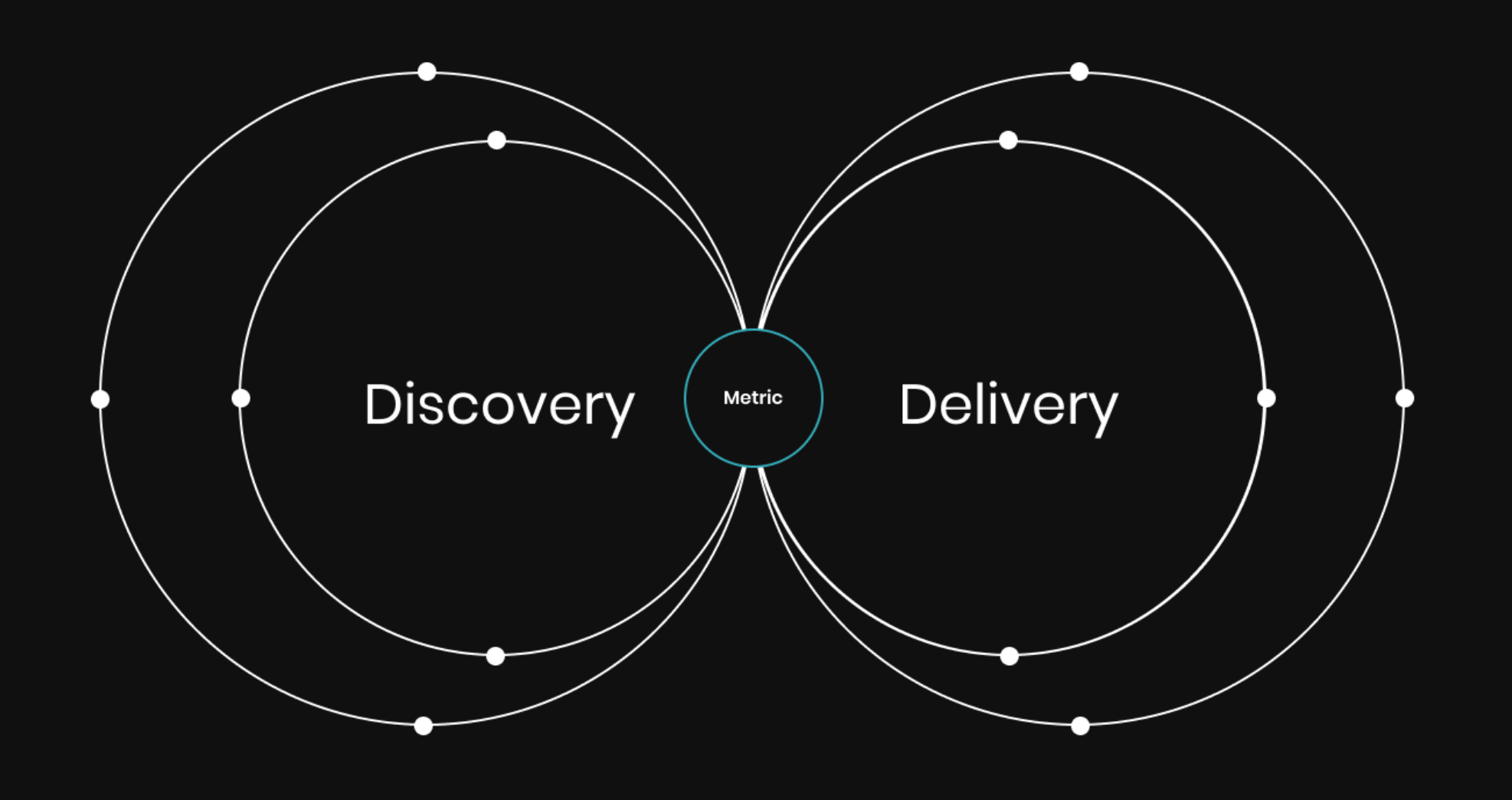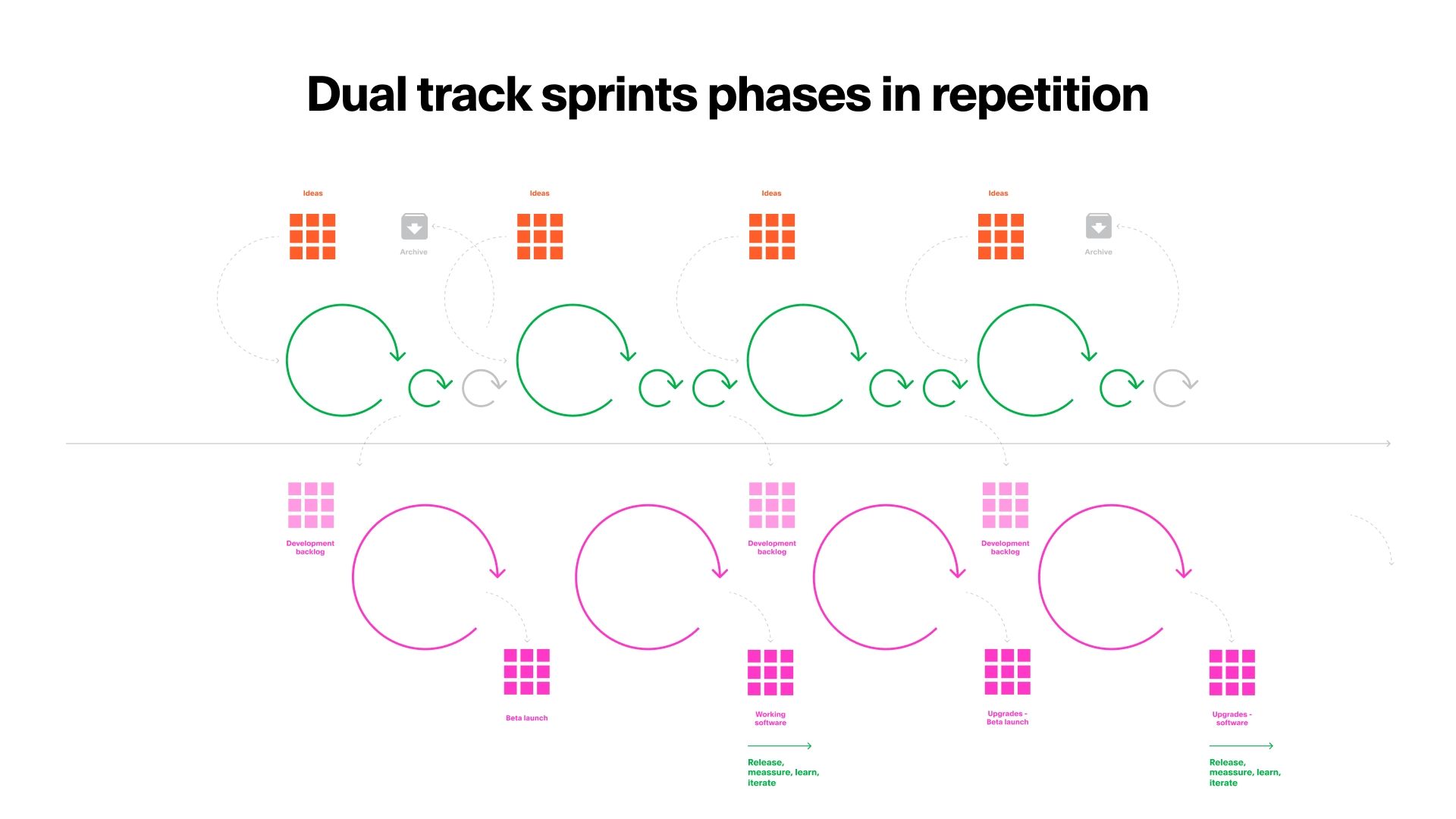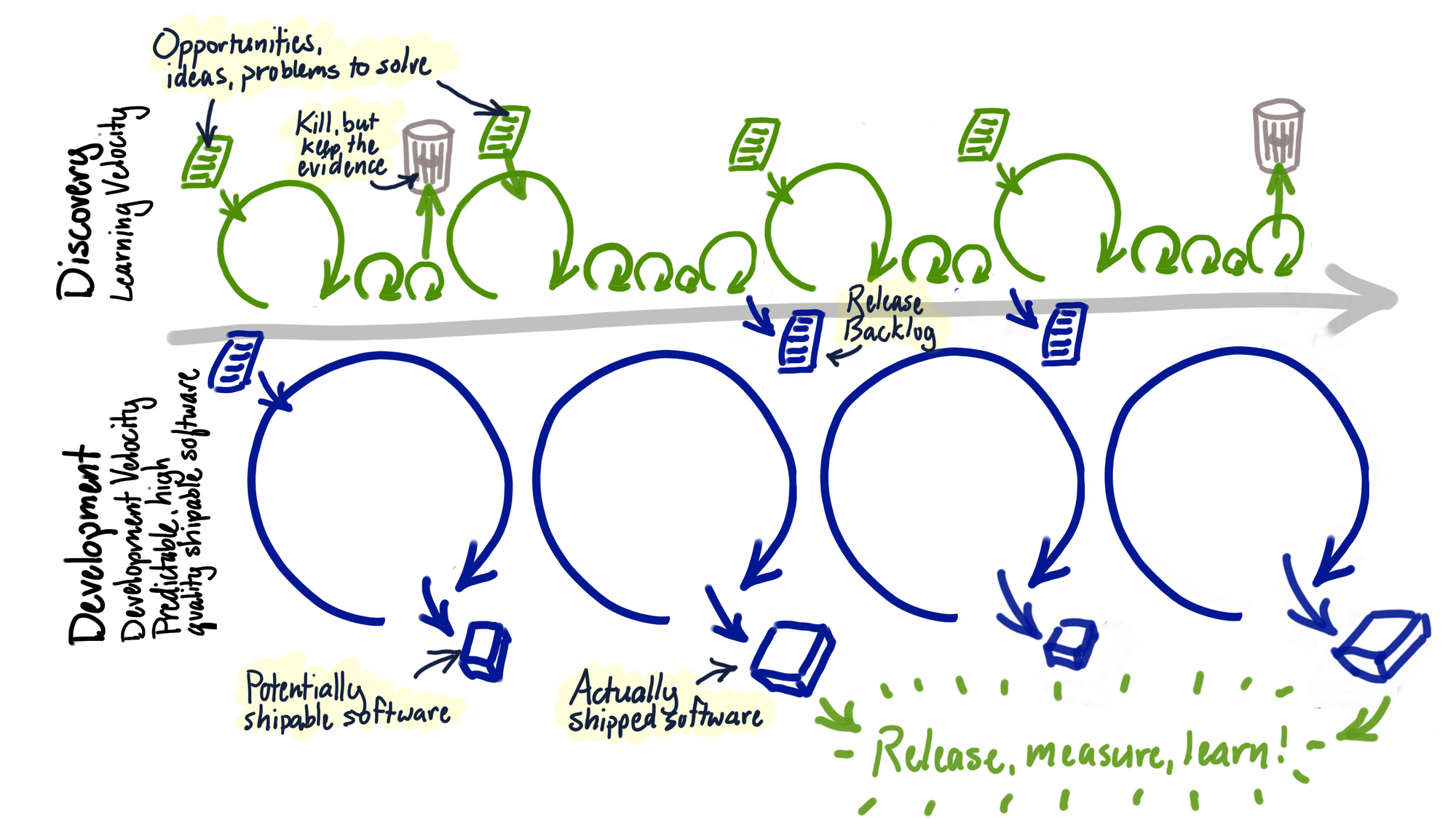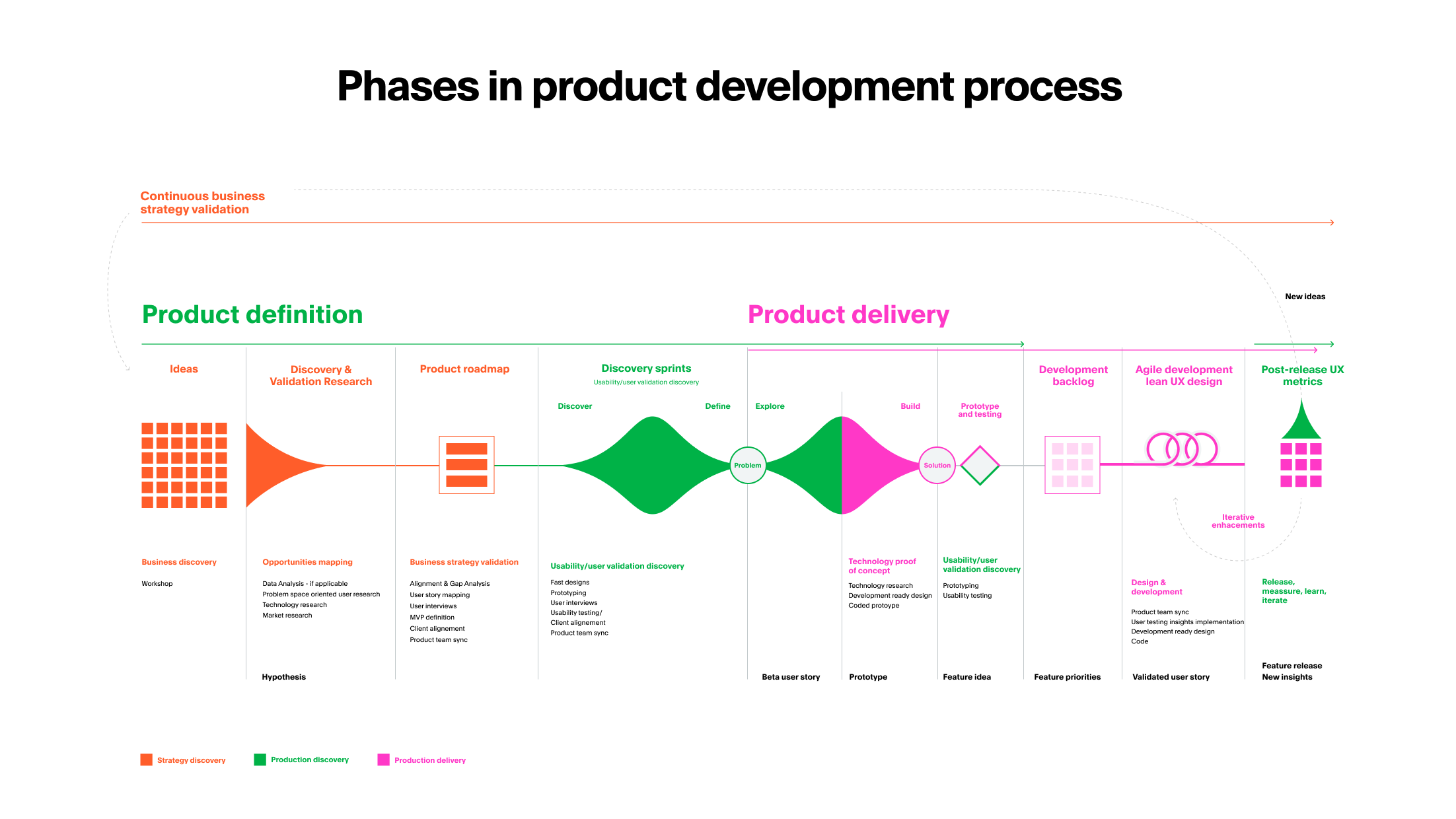Dual Track Agile
Struggling to build products users want? Stop playing the guessing game. This comprehensive guide explores how dividing work into discovery and delivery unlocks faster innovation, tighter alignment, and happy customers.

The Ultimate Guide to Dual-Track Agile: How to Make Your Projects More Successful
Launching new products is exhilarating. The rush of ideation, the meticulous crafting, unveiling your shiny new offering to the world. But often, products fail to connect with users as intended.
All that effort feels wasted when your product falls flat.
We've all been there - disappointed users, plummeting metrics, and the looming sense that months of work was for naught.
Dual-track agile provides a framework to avoid these pitfalls and set your product up for success. With dedicated teams simultaneously discovering innovative ideas and nimbly delivering on product priorities, dual-track agile keeps the entire organization laser-focused on delighting users.
This complete guide will illuminate how dual-track agile can transform the way your company innovates.
You'll learn the origins of this process, its proven benefits, tips for implementation, and real-world examples of the astounding impact it can have.
With the right approach, your next product launch will shift from radio silence to roaring ovations.
Get ready to discover how dual-track agile can help you build products users love.

Dual-Track Agile is a methodology that advocates for quickly generating validated product backlog items, and for generating releasable software in parallel. This approach is designed to reduce the amount of waste and rework in the product development process, and to improve the speed and quality of the final product.
Dual-Track Agile: Definition and Origins
Dual-track agile is a product development framework that divides work into two distinct but interconnected tracks - discovery and delivery. The discovery track focuses on quickly exploring ideas, gathering customer feedback, and validating product concepts. Meanwhile, the delivery track concentrates on taking validated ideas and efficiently turning them into shippable products.
This approach was first coined as "dual-track Scrum" in the early 2010s by Robert C. Martin, or "Uncle Bob", a renowned software engineer. Martin recognized that the standard Scrum process of fixed sprints and backlogs often led teams to work in isolation without a customer focus. Dual-track Scrum aimed to fix this by adding a continuous discovery process focused on rapid prototyping and validation.
Over time, the "Scrum" label was dropped as dual-track practices expanded beyond agile software teams. Today, dual-track is applied more broadly to any product development approach that divides work into discovery and delivery streams. The core ideas of continuous customer engagement from Martin's dual-track Scrum remain at the heart of modern dual-track implementations.
The Two Tracks: Discovery and Delivery
Dual-track agile is centered around two simultaneous tracks - discovery and delivery.

The discovery track focuses on identifying and validating potential product opportunities. This involves rapidly prototyping and testing ideas with real users, gathering feedback, and determining what solutions customers find valuable. The discovery track aims to explore the problem space, ideate solutions, and zero in on high-potential product concepts.
Meanwhile, the delivery track takes the most promising ideas validated by discovery and builds them into actual products. This track manages the engineering process of turning concepts into working software and features. The delivery track focuses on predictable execution, efficient development, and bringing product ideas to life for customers to use.
While discovery and delivery progress in parallel, they maintain tight integration through constant communication and shared goals. Insights uncovered in discovery inform the product roadmap and backlog managed by delivery. And the delivery track provides feedback on technical feasibility and timelines. This interplay between the dual tracks drives product innovation and development forward.
Building Effective Dual-Track Agile Teams
Implementing a dual-track agile framework requires thoughtfully compiling each team to match their objectives. Similar to assembling a crew for a complex heist in Ocean's Eleven, you need the optimal blend of expertise and personalities on each squad to accomplish the overarching mission.

The delivery team demands diligence, precision, and perfectionism to maintain and incrementally improve existing systems. Engineers on this team need patience for tedious tasks and excellent quality assurance skills to meet reliability standards. Since they support live products, stability team members should have operational experience and comfort with established processes.
In contrast, the discovery team requires creativity, flexibility, and vision to explore new ideas. Engineers on this team should have entrepreneurial spirits and prototyping skills to rapidly test concepts. Since they operate in ambiguity, innovation team members need high tolerance for uncertainty and collaboration abilities to brainstorm solutions.
Like Danny Ocean selecting his crack team of specialists, leaders must align dual-track agile teams based on project goals, technical needs, and team dynamics. Precision in compiling these complementary squads allows organizations to balance innovation alongside stability, enabling bold new initiatives without compromising existing systems.
The Discovery Team: Imagining the Future
The discovery team is responsible for understanding user needs, exploring new ideas, and charting the future vision for the product. They are the pioneers, always on the lookout for new opportunities.
Core roles on this SWAT team include:
- Product Manager
Leads discovery efforts and sets vision - User Researchers
Immerses in customer insights - UX Designers
Rapidly prototypes new concepts - Technical Leads
Vets feasibility of ideas
This multidisciplinary unit thrives on creativity, collaboration, and a passion for innovation.
The Delivery Team: Delivering the Goods
Meanwhile, the delivery team takes the baton from discovery and focuses on operational excellence. They build, test and refine the product features to meet customer needs.
The delivery team needs experts at executing quickly and reliably:
- Scrum Master
Keeps team on track - Developers
Codes new features - QA
Ensures quality of releases - DevOps
Enables continuous delivery
This group takes pride in their workmanship and values predictability, quality and attention to detail.
Bridging the Divide
While the two teams operate autonomously, it's critical they sync up routinely. Shared rituals like sprint reviews, backlog grooming and roadmap planning enable alignment.
Like a tag-team duo, discovery and delivery develop a tight rapport, communicating frequently to exchange insights, plans and feedback. This fosters shared purpose and brings dual-track agile to life!
Staying Aligned as a Team Transitions
For dual-track agile to succeed, close coordination is essential, especially when a single team transitions between the discovery and delivery phases. During discovery, the team focuses on experimenting with new ideas and validating concepts. As they transition to delivery, the team shifts to building production-ready features.

Schedule regular check-ins at the end of each discovery cycle and the start of delivery. Use these sync points to finalize the product backlog based on what was learned in discovery. The product owner and team should agree on scope and priorities for the upcoming delivery cycle.
Some team members may continue discovery work or spikes during delivery. They can share results during stand-ups and demos to inform the ongoing feature development. The delivery work should take priority, but insights from concurrent discovery can help guide or refine the features.
If the team composition changes between discovery and delivery, ensure knowledge transfer happens during the transition. Have outgoing members share background on design decisions, research findings, and remaining unknowns. This context helps the new or rotated members ramp up smoothly.
With good coordination and information sharing, a single agile team can fluidly transition between exploring ideas and delivering value. The insights gained during discovery cycles continuously inform feature development, keeping the output aligned with latest learnings. This ability to pivot and realign smoothly is a key benefit of dual-track agile done well.
Benefits of Dual-Track Agile
Adopting a dual-track agile approach can offer significant benefits, including:
- Managing a vast product space
With continuous discovery happening in parallel, dual-track agile enables exploration of a wide variety of ideas and opportunities simultaneously. This avoids prematurely narrowing the focus too early. - Shortening delivery time
The discovery process filters out less viable solutions earlier, allowing the delivery track to focus on high-value features that customers want most. This results in faster time-to-market. - Facilitating stakeholder management
The clear separation of discovery and delivery provides focus for stakeholders from different parts of the business. - Improving team communication
The integration between discovery and delivery necessitates close collaboration between teams with different skillsets and perspectives. This improves cross-functional communication. - Navigating the product space
The dual tracks offer balance between exploring new ideas in discovery and exploiting existing knowledge to build products in delivery. This combination enables effective navigation of the product space. - Lowering costs
Eliminating wasteful work on ideas users don't want reduces unnecessary development costs and overhead.
Dual-track agile offers a multitude of advantages, from exploring a vast product space to lowering costs. By dividing product development into continuous discovery and efficient delivery, teams can pursue high-impact ideas while avoiding wasted effort. This approach manages the inherent tensions between exploring and exploiting, ideation and execution. With dual-track agile, organizations can facilitate stakeholder collaboration, accelerate delivery, and create products that customers truly want.
Adopting this framework leads to tighter alignment between business needs and technical work. Both tracks are focused on delighting users, but pursue this goal through different means. When discovery and delivery come together, products can rapidly evolve to maximize value. Teams can navigate uncertainty, adapt to learnings, and satisfy customers. Dual-track agile provides the speed, collaboration, and customer obsession needed to thrive in competitive markets and build great products.
Challenges and Solutions in Dual-Track Agile
While dual-track agile offers many benefits, adopting this approach also comes with challenges that teams should plan for:
- Balancing discovery and delivery
It can be difficult to allocate resources and effort appropriately between the two tracks. Having clear priorities and synchronization points is key. - Adapting to market changes
The discovery process must stay on top of evolving customer needs and new competitive threats. Building in testing and feedback loops helps teams pivot. - Maximizing team value
Specialists like designers, developers, and business strategists must collaborate across functional silos. This requires careful workforce planning and coaching.
There are solutions available to mitigate these common dual-track hurdles:
- Schedule regular touchpoints where discovery shares insights and delivery provides feedback on technical options.
- Employ a strong product owner to set priorities and ensure both tracks align to strategic goals.
- Invest in tools and training to facilitate collaboration across disciplines.
- Monitor carefully for warning signs like stalled discovery efforts or technical debt accumulation.
With the right organizational support and a proactive approach, teams can avoid pitfalls and maximize the power of the dual-track system.
Case Studies and Success Stories
Dual-track agile has been implemented successfully across a variety of industries and organizations, leading to better product development outcomes and improved customer satisfaction:
- Netflix
Netflix adopted dual-track agile in 2017 to split their product team into discovery-focused "innovation" teams and delivery-focused "product" teams. This structure enabled them to rapidly explore new product areas while continuing to refine their core service, leading to breakout hits like their mobile downloads feature. - Coaching Firm
An agile coaching firm struggled with disjointed collaboration between their sales and delivery teams. Implementing dual-track agile unified these functions into discovery and delivery tracks focused on customer needs. This realignment led to faster product iterations, increased sales, and higher customer retention. - Healthcare Startup
A healthcare startup used dual-track agile to balance exploring ideas for novel digital health tools while also incrementally building and releasing their core remote patient monitoring platform. Separating discovery and delivery allowed them to validate concepts cheaply while still meeting their first product launch within 6 months. - European Bank
A European digital bank found dual-track helped their mobile app team stay aligned with changing customer expectations. Their discovery track rapidly prototyped and tested new features with users. Approved ideas were then built by the delivery track, enabling the bank to frequently release updates improving their app rating.
These examples demonstrate the power of dual-track agile to boost agility, spur innovation, and keep products tightly aligned with evolving user needs across diverse domains.
Conclusion
Dual-track agile can have a profound impact on the success of product development efforts. By balancing discovery and delivery, teams stay laser-focused on delighting their customers throughout the product lifecycle.
This approach keeps product visions grounded in real user needs, not just abstract ideas. The discovery track's rapid experimentation and feedback loops remove waste and prevent costly missteps. Handing off only the most validated concepts to the delivery track results in higher quality products that solve real problems for customers.
At the same time, dual-track agile prevents innovation from stagnating in endless discovery cycles. The delivery track's focus on execution and results ensures teams ship products efficiently. This combination of insightful discovery and disciplined delivery leads to better product-market fit, faster time-to-market, and continuous evolution based on user feedback.
For organizations struggling with their product development process, implementing dual-track agile can be a game-changer. Some resistance to this new way of working is expected, but the impact on team collaboration, product quality, and customer satisfaction make overcoming growing pains worthwhile. With the right commitment and leadership support, dual-track agile can transform product building from a risky guessing game into a strategic capability.
Adopting this approach lays the foundation for teams to thrive in competitive markets and build products users love. Dual-track agile provides the secret sauce for product success through its laser focus on the customer, rapid iteration, and synergistic discovery and delivery.

